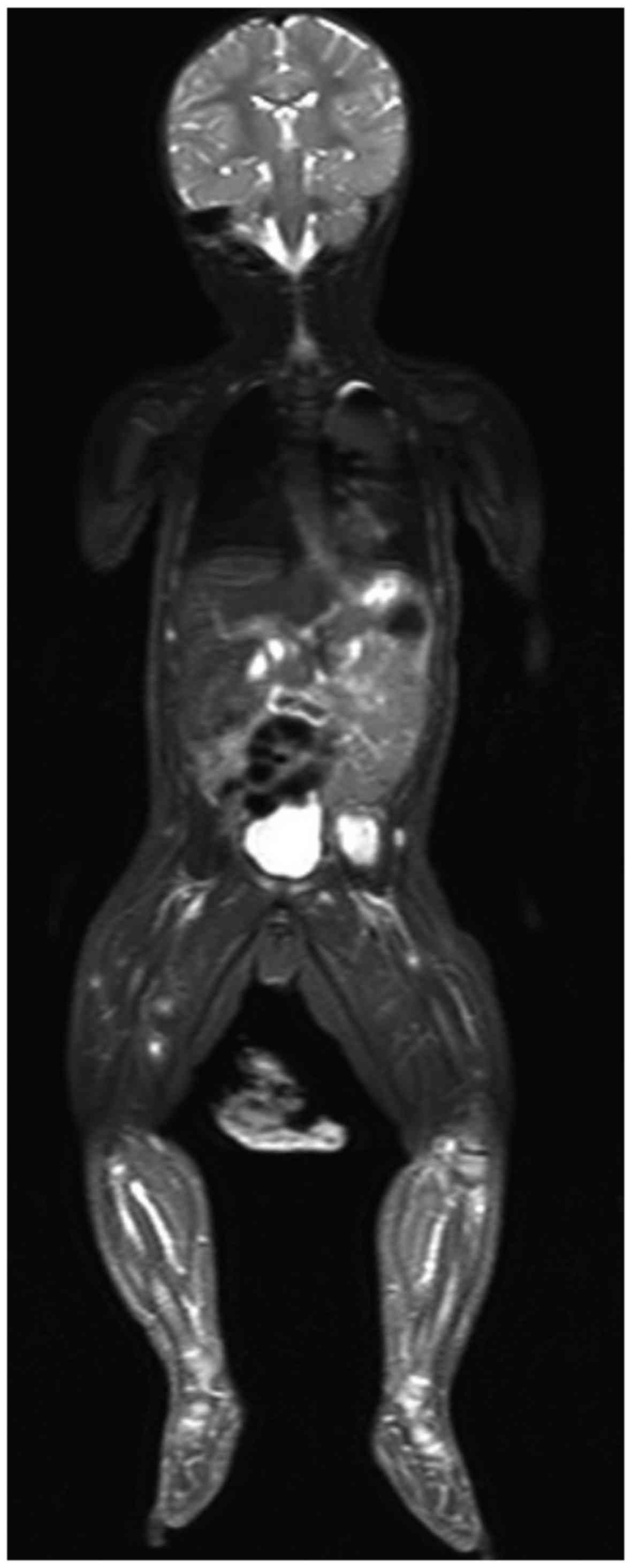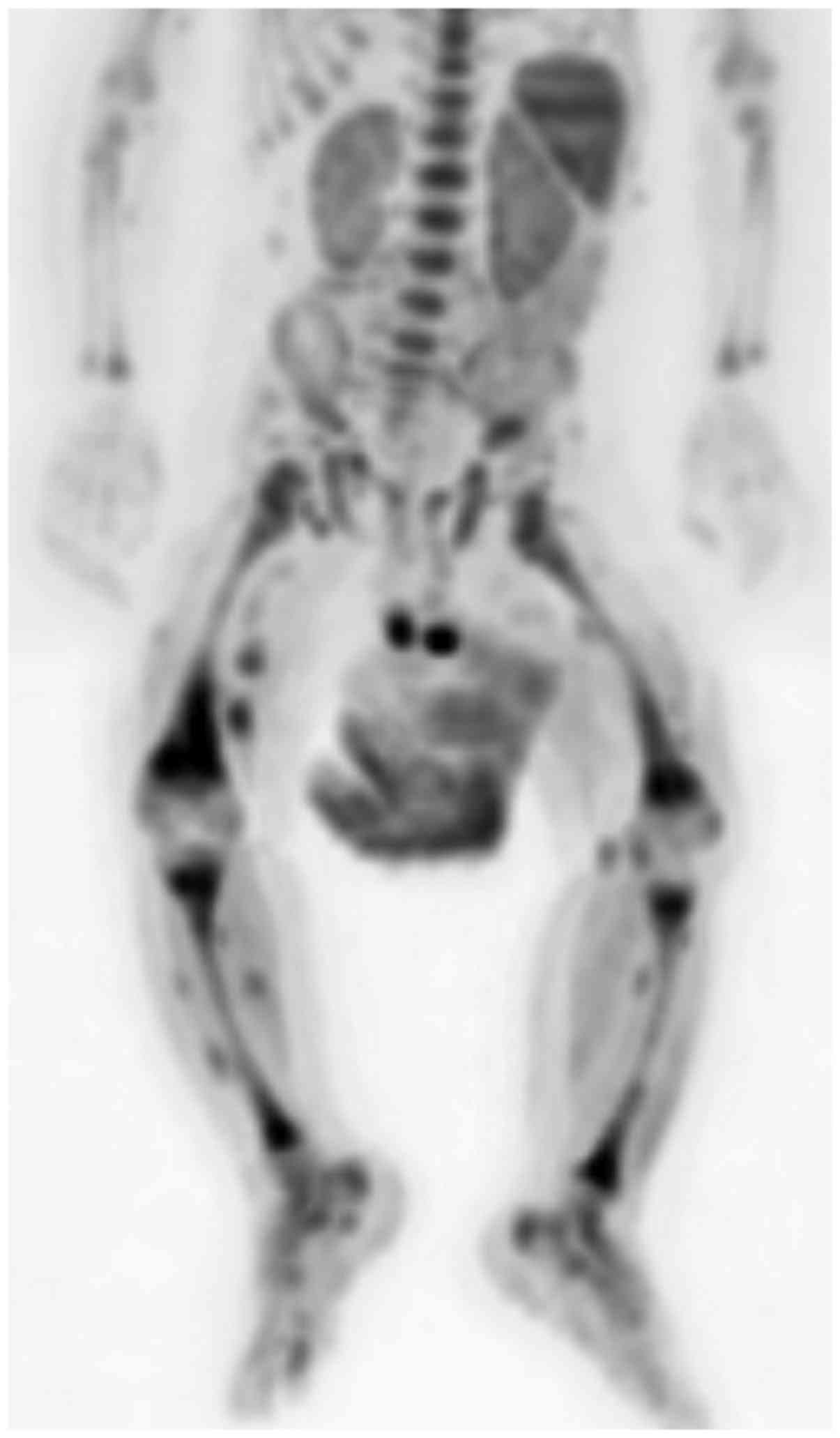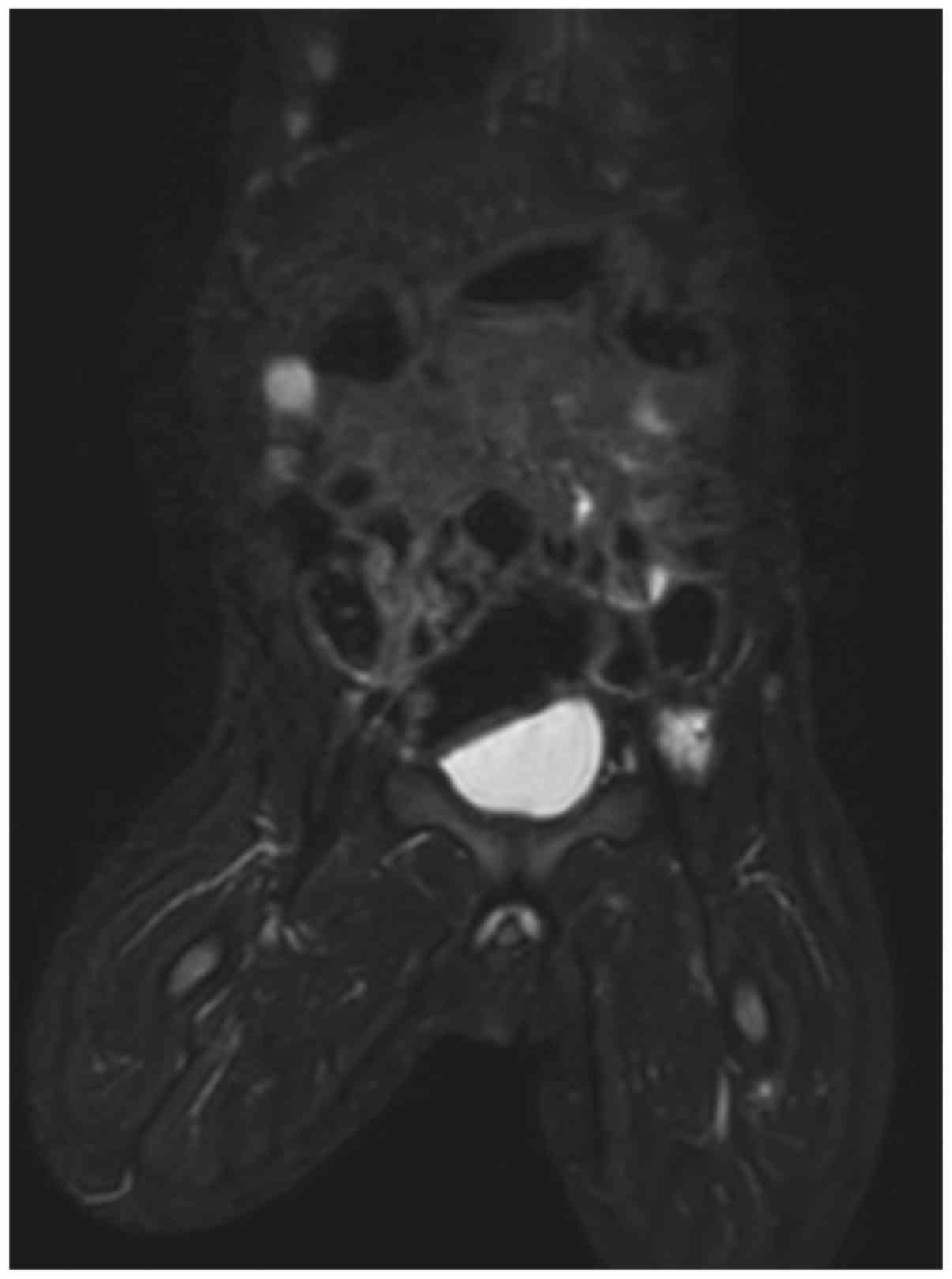Whole-body magnetic resonance imaging in the diagnosis and follow-up of multicentric infantile myofibromatosis: A case report
- Authors:
- Published online on: February 17, 2017 https://doi.org/10.3892/mco.2017.1171
- Pages: 579-582
Abstract
Introduction
Myofibromatosis is the most common fibrous tumor of infancy or childhood, often misdiagnosed due to its variable clinical and imaging characteristics; the differential diagnosis includes metastatic neuroblastoma, rhabdomyosarcoma, histiocytosis X or hemangiopericytoma (1–3). Examination of a pathological specimen is mandatory for ruling out malignancies that may require different management (4).
The clinical behavior of myofibromatosis may vary between a benign solitary or multicentric form, with involvement of muscles, bones and subcutaneous tissues, and a diffuse multicentric form with visceral involvement and a worse prognosis (1,4). Conservative management and observation are preferred for the solitary or multicentric forms without visceral involvement, as they usually undergo spontaneous regression; occasionally, surgery is suggested to reduce eventual mass effect symptoms. Aggressive treatment with radiotherapy, chemotherapy and radical surgery is used for disseminated forms with visceral involvement (1,4,5).
Clinical/radiological diagnosis and follow-up are crucial for determining disease localization and prognosis (6).
We herein describe a case of multicentric musculoskeletal myofibromatosis, investigated with whole-body magnetic resonance imaging (MRI) to assess different lesions without X-ray exposure, in order to follow disease evolution and/or regression, including early exclusion of visceral involvement, which is mandatory for prognosis and treatment.
Case report
A 3-month-old male infant, asymptomatic, born to term after an uneventful pregnancy, without a noteworthy family history, was referred to the University Hospital Paolo Giaccone in April, 2014, due to multiple, firm, painless swellings on the trunk and abdomen, covered by flesh-coloured skin.
The laboratory tests were inconclusive and misleading, including a mild increase in neuronspecific enolase to 27 ng/ml (normal, <15 ng/ml).
An ultrasound (US) examination revealed multiple heterogeneously hypoechogenic lesions, with scarce inner and peripheral vascularization, located in the left breastplate, right deep intercostal muscles and the rectus abdominis muscles bilaterally. Grade 2 left pyelectasis was also detected on abdominal US (image not shown).
Due to the suspicion of neuroblastoma based on US examination and laboratory tests, a nodule located in the right rectus muscle was selected for removal, due to its easy accessibility and low deep subcutaneous invasion, and was subsequently analyzed by histology. The tumor was characterized by tangles of spindleshaped elements, it was smooth muscle actin (SMA)+, desmin− and S100−, rich in cellular components in the periphery and exhibiting central hyalinization. No mitotic activity or cell atypia were identified, and the diagnosis of infantile myofibromatosis was established.
Whole-body MRI was performed for panoramic localization of the nodules using short TI inversion recovery (STIR) and diffusion-weighted whole-body imaging with background body signal suppression (DWIBS) sequences in the coronal or axial planes and volumetric 3D reformatting, to provide a detailed assessment of the lesions and an accurate estimation of the disease status.
The MRI revealed a significant number of nodules (~70 lesions), with almost exclusive muscle localization, in the head, trunk, abdomen, and upper and lower limbs.
STIR revealed multiple widespread lesions, characterized by a hyperintense core, surrounded by a rim of low signal (Fig. 1). The largest lesion was detected in the left iliopsoas muscle (34×26×20 mm), whereas no compression or infiltration of adjacent tissues was observed, other than mild ureteral compression.
DWIBS displayed multiple widespread loci of high intensity (Fig. 2), which on the apparent diffusion coefficient map exhibited an intermediate inner signal and a lower signal on their rim.
A blurred mass in the IX right rib was also identified; thus, to assess bone invasion and lung involvement, an unenhanced lowdose computed tomography (CT) scan was performed, which revealed a round cortical enlargement, but without a sclerotic rim, in the IX rib; the lungs were of otherwise normal appearance.
On the basis of the histological and radiological characteristics, the diagnosis of multicentric musculoskeletal myofibromatosis without visceral involvement was confirmed. Clinical observation was considered the best approach in this case. The patient was discharged after 1 week and follow-up with clinical examination and whole-body MRI re-evaluation was performed at 1 year, demonstrating a reduction in the size and number of the lesions (Fig. 3). A noticeable regression of disease was achieved and further clinical follow-up was scheduled. The last physical examination was performed 2 years after the first referral, reporting no palpable nodules or other symptoms. Therefore, no further hospital follow-up was planned. The patient's parents gave their consent to the publication of the case details and associated images.
Discussion
Myofibromatosis is the most common fibrous tumor of childhood, with 88% of the cases occurring prior to the age of 2 years. The lesions may be present at birth, or may develop during early infancy; solitary tumors mainly affect males, whilst the multicentric form is more common in females (1,7). The precise etiology remains unknown, but genetic factors, autosomal dominant as well as recessive, appear to be implicated (5).
Myofibromatosis clinically presents as single mass or diffuse multiple nodules that may develop anywhere, from the skin to subcutaneous tissues or viscera, characterized by spindle-shaped cells, SMA and vimentin positivity, related to myofibroblast proliferation; the lesions are often associated with richly vascular central areas, hemangiopericytomalike, frequently displaced by sheets of hyalinization or necrosis and calcification due to extensive apoptosis (3–5). According to several authors, hemangiopericytoma and infantile myofibromatosis are a continuous spectrum of a single myofibroblast disease (8). Therefore, the appearance on radiological investigation may vary on the basis of the abovementioned criteria (6).
Prognosis and treatment depend on the disease type, namely the solitary or multicentric form with subcutaneous, muscular and osseous involvement, or the multicentric form with visceral spread. Solitary or multicentric disease without visceral involvement is usually associated with a very good prognosis with spontaneous regression, whereas the multicentric form with visceral spread requires aggressive surgery and/or radiotherapy and chemotherapy; however, the prognosis is often poor, particularly when the lungs are involved (1,4,5). A solitary visceral form has rarely been reported, and its prognosis and treatment depend on the involved organ and associated symptoms (7).
For the abovementioned reasons, the determination of disease extent and progression with imaging are mandatory (6). US is the firststep examination, due to its availability, lack of ionizing radiation, and no need for sedation; however, the findings are often nonspecific, and US cannot fully investigate deep lesions, bone spread, visceral and lung involvement (3).
The lesions of myofibromatosis appear on CT scan as masses that exhibit soft tissue attenuation, or mildly higher, although lower attenuation is also possible due to necrosis, and sparse hyperdense loci of calcification may be present as well (3,5).
However, CT scan should be avoided when possible, due to ionizing radiation exposure and its relatively low contrast resolution for soft tissues. CT should be limited to determining eventual lung or bone involvement; the latter is usually seen as lytic lesions, with or without cortical sclerosis, which is more commonly observed when the lesions start to heal. Pulmonary involvement is usually correlated with a worse prognosis (3–5).
MRI is considered a gold standard imaging technique for soft tissue evaluation, due to its ability to provide a radiationfree detailed assessment of the disease, even without contrast media administration; it also enables early detection of visceral involvement in myofibromatosis (6). MRI may also provide high-accuracy musculoskeletal images and distinguish between various tissues, such as muscle, fibrous tissue and fat.
In radiological literature, myofibromatosis nodules usually display different MRI signals, depending on the main pattern of the lesions, or on their ‘age’, according to several authors (5,8): Younger nodules, characterized by an immature, highly vascular central component (hemangiopericytoma like) surrounded by bundles of myofibroblasts, are iso/hypointense on T1W images before and after contrast compound administration, and exhibit heterogeneous gadolinium (Gd) enhancement and high signal on T2W sequences (5,6). In older lesions, the immature core is replaced by mature myofibroblasts, or more often involutes in sheets of hyalinization or necrosis and calcification. T1W sequences usually reveal intermediate or lower intensity compared with the surrounding muscle, and noticeable peripheral heterogeneous Gd enhancement (target appearance), whereas in T2W images they display a hyperintense core due to central necrosis. Inner low signal foci in all sequences are detected in case of inner lesion calcifications (3,5,6).
MRI plays a pivotal role in cases of widespread soft tissue nodules characterized by myofibroblast proliferation in pediatric patients, particularly when performed as whole-body MRI, in order to evaluate multiple diffuse lesions (9).
Until recently, whole-body evaluation of multicentric disease was only performed by nuclear medicine, involving exposure to high doses of radiation. MRI, due to the new dedicated coils, self-sliding table, new reconstruction software and use of fast sequences, may substitute PET in certain cases of cancer staging and in other systemic diseases (9).
Whole-body MRI enables a complete imaging survey within a short time and allows panoramic detailed imaging of all lesions sized >6 mm, it is able to investigate spread to contiguous organs and may also be used in the follow-up to determine lesion reduction and shrinkage, as in the present case. Fast image acquisition is also useful in pediatric patients to reduce sedation time during MRI acquisition (9,10).
Although there is no standardized technique for performing whole-body MRI, the main sequences are STIR and DWIBS. T1W, with or without contrast administration, increases specificity, but it is not routinely performed as it prolongs scanning time (10).
The application of STIR sequences in pediatric MRI is well accepted, since the signal may aid in differentiating tissue characteristics; in fact, the majority of the pathological lesions are proton-rich and have extended T1 and T2 relaxation times, exhibiting high signal on STIR, along with its ability to provide images within a short time frame and to better suppress fat signal compared with other T2 fat-saturated sequences (9,10).
DWIBS sequences provide information on lesion architecture and enable functional 3D imaging of systemic disease in freebreathing acquisition, depicting highly cellular tumors and necrosis as high-signal lesions (9,10).
Moreover, DWIBS acquisitions can be postprocessed, obtaining whole-body images in coronal planes and, inverting the grey scale, it is possible to create PET-like images (9).
Whole-body MRI is a well-accepted imaging modality for staging lymphoma; this modality has been extended to the safe evaluation of other systemic diseases, found to be useful when a whole-body panoramic assessment of a disease is required, not only to establish its true extent, but also during follow-up to determine its evolution (6,9). It must be mentioned that the sensitivity of whole-body MRI with T1 and STIR sequences is comparable to that of PET/CT in the detection of metastatic diseases. DWIBS sequences increase sensitivity by demonstrating tissue cellular architecture (9).
Whole-body MRI has shown to be able to provide a detailed panoramic view of systemic disease along with functional information within a reasonable time frame, without breath holding and without radiation exposure, in a single short sedation session. In the present case, whole-body MRI easily assessed all the sites of myofibromatosis lesions, and provided detailed information regarding the extent of the disease, spread in contiguous organs and its evolution during follow-up.
References
|
Chung EB and Enzinger FM: Infantile myofibromatosis. Cancer. 48:1807–1818. 1981. View Article : Google Scholar : PubMed/NCBI | |
|
Gopal M, Chahal G, Al-Rifai Z, Eradi B, Ninan G and Nour S: Infantile myofibromatosis. Pediatr Surg Int. 24:287–291. 2008. View Article : Google Scholar : PubMed/NCBI | |
|
Koujok K, Ruiz RE and Hernandez RJ: Myofibromatosis: Imaging characteristics. Pediatr Radiol. 35:374–380. 2005. View Article : Google Scholar : PubMed/NCBI | |
|
Larralde M, Hoffner MV, Boggio P, Abad ME, Luna PC and Correa N: Infantile myofibromatosis: Report of nine patients. Pediatr Dermatol. 27:29–33. 2010. View Article : Google Scholar : PubMed/NCBI | |
|
Murphey MD, Ruble CM, Tyszko SM, Zbojniewicz AM, Potter BK and Miettinen M: From the archives of the AFIP musculoskeletal fibromatoses: radiologic-pathologic correlation. Radiographics. 29:2143–2173. 2009. View Article : Google Scholar : PubMed/NCBI | |
|
Counsell SJ, Devile C, Mercuri E, Allsop JM, Birch R and Muntoni F: Magnetic resonance imaging assessment of infantile myofibromatosis. Clin Radiol. 57:67–70. 2002. View Article : Google Scholar : PubMed/NCBI | |
|
Menéndez-Arzac R, Valdez-Méndez D, Landa R, Guzmán S, Cárdenas E and Cano AM: Solitary infantile gastrointestinal myofibroma: Case report. J Pediatr Surg. 40:1361–1363. 2005. View Article : Google Scholar : PubMed/NCBI | |
|
Mentzel T, Calonje E, Nascimento AG and Fletcher CD: Infantile hemangiopericytoma versus infantile myofibromatosis. Study of a series suggesting a continuous spectrum of infantile myofibroblastic lesions. Am J Surg Pathol. 18:922–930. 1994. View Article : Google Scholar : PubMed/NCBI | |
|
Chavhan GB, Babyn PS and Whole-Body MR: Imaging in Children: Principles, Technique, Current ApplicationsCurrentApplications, and Future Directions. Radiographics. 31:1758–1774. 2011. View Article : Google Scholar | |
|
Teixeira SR, Junior J Elias, Nogueira-Barbosa MH, Guimarães MD, Marchiori E and Santos MK: Whole-body magnetic resonance imaging in children: State of the art. Radiol Bras. 48:111–120. 2015. View Article : Google Scholar : PubMed/NCBI |












